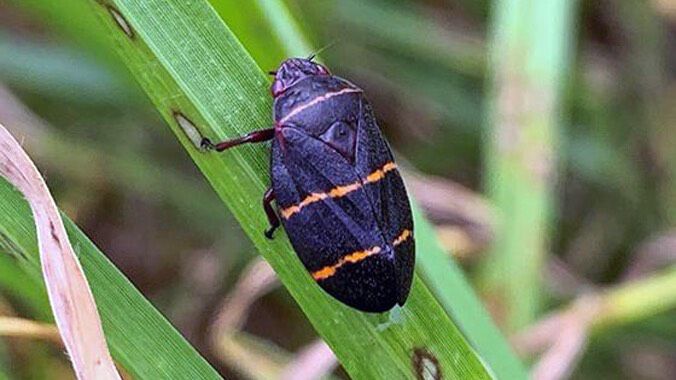Agriculture and bio-control experts are warning that the two-lined spittlebug, the latest in a growing rogues gallery of invasive pests to threaten the state’s ecological and economic wellbeing, requires immediate attention lest the pasture-ravaging insect spread from a so-far contained area on Hawaii island across the island chain a la little fire ants and coconut rhinoceros beetles.
The state Legislature appears to be heeding the warnings, quickly advancing a House measure that would fund the Hawaii Department of Agriculture’s efforts to mitigate and control the pest as well as recovery efforts for affected areas.
House Bill 2131, House Draft 2, cleared the House a week ago and on Monday received a unanimous nod from the Senate Committee on Agriculture and the Environment.
The two-lined spittlebug (Prosapia bicincta), which is native to the southeast United States, was first detected on Hawaii island in 2016 and within five years had spread across 178,000 acres of pasture land in Kailua-Kona, devouring kikuyu grass and other forage crops used to feed livestock and threatening the state’s $68 million livestock industry.
“This really is a contained pest right now,” said Hawaii Invasive Species Council planner Chelsea Arnott. “If we don’t add more resources to the actual management of two-lined spittlebug on the west side of Hawaii island, this is going to be kind of like a little fire ant issue, where we are asking for more and more resources year after year.”
Dexter Kishida, HDOA deputy to the chair, said the insect poses a dual threat.
“The two-lined spittlebug destroys the kikiyu and the grasses currently but then a bunch of invasive weeds then pop up, which require even more mitigation,” he said. “So if we can control the spittlebug from the front end, it will reduce the cost to both the farmer and the state.”
In written testimony to the committee, HDOA also noted that spittlebug infestations can generate fire fuel “through dead grasses and large amount of ‘brown material’ and by allowing weeds that are more fire prone and long-term fire resistant, to occupy the range landscape.”
HDOA already has a tentative agreement with the Florida Department of Agriculture and Consumer Services to collaborate on a biocontrol program that would try to identify natural enemies of the spittlebug. The proposed project would cost an estimated $100,00 to launch. Overall, HDOA is seeking $800,000, to fund an existing spittlebug research program and requests from the University of Hawaii and the Hawaii Cattleman’s Council to address the total needs of the impacted range lands and related threats to the watershed.
The original bill specified an appropriation of $800,000 but the current draft leaves the figure unspecified. At Monday’s hearing, Hawaii Farm Bureau executive director, testifying in support of the measure, requested that the $800,000 be retained in the final version.
Nicole Galase, managing director of the Hawaii Cattlemen’s Council, said the two-lined spittlebug affects both conservation goals and food production.
“The opportunity here is that it is currently contained in Kona, so we have the chance to keep it in check before it gets out of control. Those ranches in Kona, they’ve been investing a lot of time and a lot of money into controlling this invasive species and they need our help to keep it from getting worse and from spreading.
“Without this action, the two-lined spittlebug will devastate Hawaii’s range lands and beef production,” she continued. “Let’s look at this as a chance to be successful in stopping an invasive species from additional damage, which we know is very difficult.”
The bill next heads to the Senate Committee on Ways and Means for further review and consideration.
Michael Tsai covers local and state politics for Spectrum News Hawaii. He can be reached at michael.tsai@charter.com.



